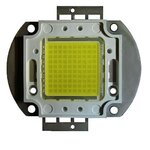jstamour802
Junior Member level 1
I need some advice on how to connect the feedback from a high-side current source.
Circuit design requirements:
- 48V supply voltage
- LED string length will vary, but can be as long as a ~40V string or more
- LED string must be connected directly to ground to work with an existing system
- Current is controllable from a DAC voltage or similar (0-3.3V)
- Circuit is pulsed, on-time=1usec or more, 0-10% duty cycle depending on current
This one is a bit trickier for me as I need the LED string tied to ground instead. I chose a MAX9643 to output a voltage proportional to the current through a high-side sense resistor, and I plan to use that to regulate the current. The MAX9643 was chosen because it can accept 60V common mode voltages and is high speed - it also looks like the simplest solution until I can work out the rest of the circuit.
The question becomes, how do I tie VOUT from the MAX9643 to an op-amp feedback loop to control the current through the mosfet? I've done some current sinks before and they are relatively simple, but I am not sure how to connect this one up properly.
Attached is a circuit I have in mind but I'm not sure how close I am. Help is appreciated!
Circuit design requirements:
- 48V supply voltage
- LED string length will vary, but can be as long as a ~40V string or more
- LED string must be connected directly to ground to work with an existing system
- Current is controllable from a DAC voltage or similar (0-3.3V)
- Circuit is pulsed, on-time=1usec or more, 0-10% duty cycle depending on current
This one is a bit trickier for me as I need the LED string tied to ground instead. I chose a MAX9643 to output a voltage proportional to the current through a high-side sense resistor, and I plan to use that to regulate the current. The MAX9643 was chosen because it can accept 60V common mode voltages and is high speed - it also looks like the simplest solution until I can work out the rest of the circuit.
The question becomes, how do I tie VOUT from the MAX9643 to an op-amp feedback loop to control the current through the mosfet? I've done some current sinks before and they are relatively simple, but I am not sure how to connect this one up properly.
Attached is a circuit I have in mind but I'm not sure how close I am. Help is appreciated!

